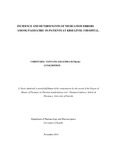| dc.description.abstract | Background
: Medication errors are any error in prescribing, d
ispensing, administration, or
monitoring of a drug and are an important cause of
patient harm. They are also the single
most preventable cause of patient harm yet when the
y occur in paediatrics patients, they
have a much higher risk of death compared to adults
. Literature suggests that children
experience medication errors up to three times more
than adults do. Some studies indicate up
to tenfold higher rate of medication errors in chil
dren.
Objective of the study:
The main objective of the study was to determine th
e incidence and
factors associated with medication errors in paedia
tric patients admitted Kisii level 5
Hospital
Methodology:
The study carried out between June and August 2014
was conducted in two
parts; a descriptive cohort study that had a quanti
tative approach and a cross sectional
survey that was qualitative in nature. The quantit
ative component entailed the prospective
review of treatment sheets and files for medication
related errors among children aged 0-5
years old admitted at the general paediatric ward a
nd newborn unit at Kisii level 5 Hospital
until discharge or up to a period of one month. Th
e qualitative component included
interviews of health care workers and caregivers al
ongside focused group discussions to
identify the medication error types and causes. De
scriptive statistics was used to determine
frequency, incidences, means, and standard deviatio
ns. The relationships between predictor
and outcome variables for dosing errors were comput
ed using logistic regression (with
significance set at p-value of 0.05 and 95% confide
nce interval). Key themes identified in
the interviews and focus group discussions were exp
lored for potential causes of medication
errors.
Results:
Out of 405 treatment sheets and files reviewed duri
ng the study, 307 contained
errors yielding an overall medication error rate of
75.8% with the total number of
medication errors observed being 1023. These erro
rs were classified into various categories
as documentation errors 756 (73.9%) which were more
frequent, followed by dosing errors (90, 8.8%), monitoring errors (88, 8.6%) and timing
errors (58, 5.7%). The medication
errors occurred more frequently in male children (1
64, 41.2%), children less than one year
(186, 45.9%) and in those admitted to the general p
aediatric ward (196, 48.4%). Logistic
regression of dosing errors revealed that children
receiving more than five medicines were
6.4 times likely to experience dosing errors (OR 6.
4; 95%CI: 2.7-15.1; P<0.001). Route of
drug administration was a significant predictor of
dosing errors with a 90% less risk of
developing a dosing error for oral routes as compar
ed to intravenous route (P <0.001).
Various causes of medication error were identified
and strategies to mitigate the occurrence
of medication errors among the paediatric in-patien
ts proposed.
Conclusion:
The incidence of medication errors was significantl
y high with about 3.3 errors
per prescription and larger studies would be approp
riate to determine the extent of
medication errors among children. Despite the fact
that majority of errors observed were
less likely to cause harm, some can be potentially
fatal and therefore there is need for
hospitals to have strategies of detecting and minim
izing the errors. | en_US |
| dc.description.department | a
Department of Psychiatry, University of Nairobi, ; bDepartment of Mental Health, School of Medicine,
Moi University, Eldoret, Kenya | |

